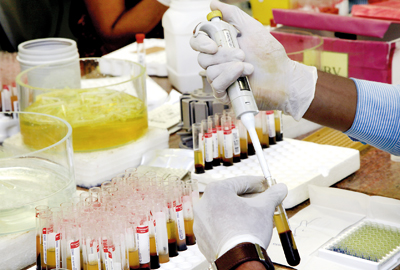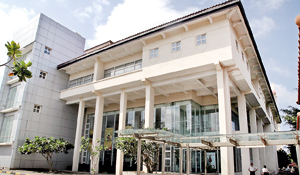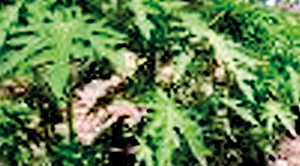NBTS infuses new blood
By Kumudini HettiarachchiThe Bubble Baby of Sri Lanka, Sanjana Praveen Shivanka, is only one example among numerous men, women and children who have to seek the life-saving procedure of bone-marrow transplantation outside Sri Lanka at great cost.

The lab where blood is screened for transfusion transmitted infections. Pix by M.A. Pushpa Kumara
Some may not be able to afford the high costs involved in seeking this treatment abroad. That is why the latest initiatives of Sri Lanka’s National Blood Transfusion Service (NBTS), with its headquarters at Narahenpita, will hold a ray of hope for these beleaguered patients. Fortunately for baby Shivanka he was able to get a bone marrow transplantation in India for the genetic disease which otherwise would have snuffed out his life, due to the support of the Sunday Times readers who raised Rs. 5.3 million.
With many awards to its credit including the most-recent of being the ‘Best Transfusion Service’ beating 28 other developing countries, the NBTS is on the threshold of two important projects, the Sunday Times learns.
A Cord Blood Banking Unit at the National Blood Centre (NBC) of the NBTS will pave the way for stem-cell transplantation in Sri Lanka, not available currently. A dedicated wing will also be built for such transplantations at the Cancer Institute at Maharagama, disclosed NBTS Director Dr. Vijith Gunasekera.
The Cord Blood Banking Unit is to be set up under a project to upgrade the NBTS with state-of-the-art technology. A Frozen Red Cell Unit along with Nucleic Acid Amplification Testing to screen blood for transfusion transmitted infections (TTIs) will also enhance the facilities, he explains, adding that it is a US-assisted project costing US$ 34 million.
The Frozen Red Cell Unit will enable the storage of red blood cells up to 10 years whereas currently they can only be stored for 35-42 days. This will be a boon to those with rare blood groups. The Nucleic Acid Amplification Testing, meanwhile, will help narrow the window period for checking the presence of infections such as the Human Immuno-deficiency Virus (HIV) and Hepatitis B and C, it is understood.
The second project supported by the Netherlands and costing US$ 31 million is to upgrade peripheral blood banks, he said.
With the NBC located within the NBTS being the “heart”, the “circulatory system” of the country is organised into 16 clusters under which are 87 peripheral blood banks. Nineteen will get brand new buildings while infrastructure development to keep the line flowing and strong such as collection of blood, processing and storing and also cold-chain management will be strengthened, the Sunday Times understands.
It was not so long ago that the NBTS was embroiled in controversy over the use of expired apheresis kits, but the Sunday Times understands that with former Director, Dr. Ananda Gunasekera, coming into the picture in 2009 there was a major turnaround which is being sustained by the present Director.
“There was a feeling among the staff that they had been let down. They were demoralised,” recalls Dr. Ananda Gunasekera of the time when he took over, with the NBTS literally in shambles. His first duty was to change the mindset of the staff and make them have confidence in themselves.
With both Drs. Gunasekera (Director and former Director) proudly accepting the award for the ‘Best Transfusion Service’ at the 23rd Congress of the International Society of Blood Transfusion held last Sunday at Cancun, Mexico and many other trophies bagged within the last few years adorning the Director’s office at Narahenpita, the mood is upbeat. Among the trophies are the Taiki Akimoto 5S Award 2010 (Trade & Service Sector– medium category) and the National Health Excellence Award 2009-10 (Gold). The NBC laboratories were also the first among state-sector labs to get ISO 15189 accreditation last year.
As the NBTS is about to traverse a clear-cut path with ambitious plans to help desperate Sri Lankans, all those troubles are behind it. Now the NBTS is only looking forward and that too to a productive future.
What is cord blood banking ?
Cord blood banking is vital because increasingly cord blood is being used to treat a variety of malignant and severe genetic diseases of the bone marrow or immune system, the Sunday Times understands.

The NBTS at Narahenpita
Usually these diseases are treated by allogeneic haemopoietic stem cell (HSC) transplantation, with the HSCs being collected from bone marrow or peripheral blood, said NBTS Director Dr. Vijith Gunasekera. But such collection of HSCs would only be possible if there is a matching donor and finding a donor is time-consuming. Even when such donors are found they are sometimes not available at the time the transplantation is needed. As such in the last decade, cord blood has increasingly been used as an alternative source.
The diseases which can be treated by HSC transplantation are Congenital Immune Deficiencies, Aplastic Anaemia, both acute and chronic Leukaemia, Hodgkin’s disease, Myelodysplasia and also Thalassaemia, it is learnt.
Cord blood as a source of HSC has many advantages, according to Dr. Gunasekera.
The Sunday Times learns that cord blood is the blood that remains in the blood vessels of the discarded placenta and the portion of the umbilical cord that remains attached to it, after a baby is born. While cord blood contains the usual red and white blood cells, platelets and plasma, it is also rich in HSCs.
Cord blood being abundantly and readily available and generally considered a waste product, it can be harvested with no risk to either the donor mother or infant, pointed out Dr. Gunasekera.The other advantages would be the ability to store fully tested cord blood units in the frozen state for immediate use, reducing disease and death among patients associated with long procurement times for bone marrow; the absence of donor attrition; low risk of viral transmission; and a higher degree of mismatch appearing to be acceptable with a comparatively reduced risk of acute and chronic graft-versus-host disease, possibly due to the naivety of the cells, it is learnt.
Meanwhile, ethnic minority groups that are markedly under-represented in Bone Marrow Donor Registries could also be targeted for cord blood collection to build up stocks.These facilities to come into being in about two years will not only save lives but also vast amounts of foreign exchange.
comments powered by Disqus















